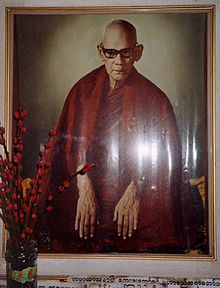- Mahasi Sayadaw
-
Mahasi Sayadaw U Sobhana
မဟာစည်ဆရာတော် ဦးသောဘန
The Venerable Mahasi SayadawReligion Buddhism School Theravada Lineage Mahasi Dharma name(s) Sobhana
သောဘနPersonal Nationality Burmese Born 29 July 1904
Seikkhun, Shwebo District, British BurmaDied 14 August 1982 (aged 78)
Yangon, MyanmarSenior posting Based in Mahasi Monastery, Yangon, Myanmar Title Sayadaw Successor U Pandita Religious career Website www.mahasi.org Part of a series on
Buddhism
Dharma or concepts
Four Noble Truths
Five Aggregates
Impermanence
Suffering · Non-self
Dependent Origination
Middle Way · Emptiness
Karma · Rebirth
Samsara · CosmologyPractices
Three Jewels
Noble Eightfold Path
Morality · Perfections
Meditation · Mindfulness
Wisdom · Compassion
Aids to Enlightenment
Monasticism · LaityNirvāṇa
Four Stages · Arahant
Buddha · BodhisattvaTraditions · Canons
Theravāda · Pali
Mahāyāna · Chinese
Vajrayāna · TibetanThe Venerable Mahasi Sayadaw U Sobhana (Burmese: မဟာစည်ဆရာတော် ဦးသောဘန, pronounced [məhàsì sʰəjàdɔ̀ ʔú θɔ́bəna̰]; 29 July 1904 – 14 August 1982) was a Burmese Theravada Buddhist monk and meditation master who had a significant impact on the teaching of Vipassana (Insight) meditation in the West and throughout Asia. In his style of practice, the meditator anchors their attention on the sensations of the rising and falling of the abdomen during breathing, observing carefully any other sensations or thoughts.
Contents
Biography
Mahāsi Sayādaw was born in 1904 in Seikkhun village in Upper Burma. He became a novice at age twelve, and was ordained at the age of twenty with the name Sobhana. Over the course of decades of study, he passed the rigorous series of government examinations in the Theravāda Buddhist texts, gaining the newly-introduced Dhammācariya (dhamma teacher) degree in 1941.
In 1931, U Sobhana took leave from teaching scriptural studies in Moulmein, South Burma, and went to nearby Thaton to practice intensive Vipassana meditation under Mingun Jetawun Sayādaw (also rendered Mingun Jetavana Sayādaw), also known as U Nārada. This teacher had practiced in the remote Sagaing Hills of Upper Burma, under the guidance of Aletawya Sayādaw, a student of the forest meditation master Thelon Sayādaw.[citation needed] U Sobhāna first taught Vipassana meditation in his home village in 1938, at a monastery named for its massive drum 'Mahāsi'. He became known in the region as Mahāsi Sayādaw. In 1947, the Prime Minister of Burma, U Nu, invited Mahāsi Sayādaw to be resident teacher at a newly established meditation center in Yangon, which came to be called the Mahāsi Sāsana Yeiktha.
Mahāsi Sayādaw was a questioner and final editor at the Sixth Buddhist Council on May 17, 1954. He helped establish meditation centers all over Burma as well as in Sri Lanka, Indonesia, Thailand, and by 1972 the centers under his guidance had trained more than 700,000 meditators. In 1979, he travelled to the West, holding retreats at newly founded centers such as the Insight Meditation Society (IMS) in Barre, Massachusetts, U.S. In addition, meditators came from all over the world to practice at his center in Yangon. When the Mahāsi Sayādaw died on 14 August 1982 following a massive stroke, thousands of devotees braved the torrential monsoon rains to pay their last respects.
Publications
Mahāsi Sayādaw published nearly seventy volumes of Buddhist literature in Burmese, many of these transcribed from talks. He completed a Burmese translation of the Visuddhimagga, ("The Path of Purification") a lengthy treatise on meditation by the 5th century Indian Theravadin Buddhist commentator and scholar Buddhaghosa. He also wrote a volume entitled Manual of Vipassana Meditation. His English works include:
- Practical Vipassana Exercises [1]
- Satipatthana Vipassana Meditation [2] [3]
- The Progress of Insight—an advanced talk on Vipassana [4]
- Thoughts on the Dharma [5]
Notable students
*Ashin Jinarakkhita/The Boan An
- Sayādaw U Paṇḍita (Panditārāma)
- Chanmyay Sayādaw (U Janakabhivamsa)
- Anagarika Munindra
- Joseph Goldstein
- Rodney Smith
- Sharon Salzberg
- G. V. Desani
- Achan Sobin S. Namto[1]
- Freda Bedi
References
- ^ "Our Teacher -". vipassanadhura.com. http://vipassanadhura.com/ourteacher.htm. Retrieved 2008-05-04.
External links
- Biographical Sketch of Mahāsi Sayādaw from Buddhanet.net
- The Venerable Mahāsi Sayādaw's Discourses and Treatises on Buddhism
- Biography of Mahāsi Sayādaw from the American Burma Buddhist Association
- Mp3-Video Clips by Mahasi Sayadaw from Myanmarnet
- Audio talks by Mahāsi Sayādaw from Edhamma.com
- [6] Rare video of Mahasi Sayadaw
- Saddhamma Foundation Information about practicing the Mahasi meditation method.
Categories:- 1904 births
- 1982 deaths
- Buddhist philosophers
- Theravada Buddhist monks
- Burmese Buddhist monks
Wikimedia Foundation. 2010.

